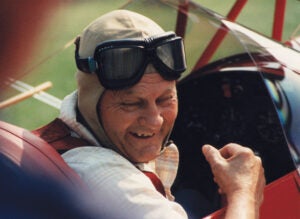A few years back, during AirVenture, a person asked me what vibration testing had been performed on the tail of the Sonex. His jargon-filled questions dug deep into theory and I had no answers for him. He grew frustrated with me and I with him. He wasn’t interested in a Sonex. He wanted me to know he was an expert in vibration frequency fatigue. When he left the Sonex booth I bet he asked the same questions of the other kit aircraft manufacturers.
Over the last 20 years, I’ve been asked very pointed questions on all manner of details only to have the questioner follow up with variations of, “Back in the ’50s tail tips were failing on Bumble Bees and I’m the guy who solved that problem.” It’s bravado. These conversations are an occupational hazard for airshow exhibitors. I’ve learned to read eyes and body language and tactfully cut these conversations short. Technology, however, allows this bull—such conversations into our workshops, where the absence of eye contact and body language can’t betray the bravado.
Words can outfox our intuition. The perception some create of themselves becomes reality. Telltale signs include: offering the same advice to everyone, offering a solution without asking additional questions, urging a fix for a problem you don’t have, speaking authoritatively on every topic, getting wrapped up in the minutia of a single topic, and touting credentials. Their bravado may be masking bull—shall we move on?

No Bull
So it was refreshing to share a square of Sonex booth shade with a builder I hadn’t seen in far too long. Our conversation transcended a particular brand of aircraft and inspired this month’s column. Its foundation was anchored in the joy of homebuilding and his desire to help others succeed in their dream to build and fly an airplane. He is an aviation booster who happens to do his work within the Sonex Aircraft community. I’m confident there are boosters in each design’s community. You won’t find him on the talk groups opining on every topic, but when called upon for help, which is often, he answers his phone to answer a question and provides onsite assistance if the distance is reasonable. One of the first things he’ll do is ask, “Did you follow the instructions?” If you haven’t, his assistance will begin by guiding you through the plans or manual. Should that fail to resolve the issue, reasoned troubleshooting begins, not knee-jerk modifications.
There is great irony that this person is a booster. His aircraft is modified beyond the design’s intent. His decision to make the modifications weighed heavily on his mind prior to their completion. He has well thought-out reasons for the modifications and acknowledges, almost apologizes for, the compromises he made to the design. The modifications weigh heavily on his airframe, too, but he operates his aircraft accordingly. In this way, he embodies what Experimental aviation is: the right to experiment and the necessity to do so responsibly. He won’t try to sell anyone on his modifications. He’s more likely to talk someone out of modifications unless he feels they have clear reasons for making them and understand the potential drawbacks.
Getting a Boost
My journey through homebuilding was paved by boosters. While I navigated the maze of decisions for building a Pietenpol, there were certain members of the Buckeye Pietenpol Association that stood out above the others. They dispensed knowledgeable advice—quarterly, through a newsletter, rather than hourly, on the internet—without pushing an agenda. Pros and cons of each building decision were addressed without bias. When the Sonex was introduced in 1998, a handful of early adopters became boosters, none more so than Tony Spicer. Tony built his award-winning aircraft at a speed that outpaced completion of the plans—he finished his airplane using official factory napkin sketches—clearing a path for others, including me, to follow. He provided aid and comfort to active builders and inspired countless others to build, or resume building, with his homemade DVD in which he took viewers flying in the right seat. Back then it was the only way to get a ride. Tony let Sonex distribute his DVD and insisted it be free. He had nothing to gain by helping others and promoting the Sonex other than the personal satisfaction of seeing a young design and its earliest adopters succeed.
When Dick Starks, math teacher, Kansas City Dawn Patrol member and frequent KITPLANES® contributor, released his book, “You Want To Build and Fly a What?,” he became a booster for more than the Graham Lee Nieuport replicas; he championed all homebuilders with his honest, sometimes bumbling, always hilarious manner. He bared his soul, embraced his shortcomings and instilled in each reader the truth that a desire to build an airplane is the only prerequisite for building one.
While any number of people can inspire you to build, once you begin you’ll benefit from identifying a booster that has built the design that has stolen your heart and your home’s equity. That person won’t have a personal agenda to advance. You’ll seldom hear the words “upgrade” or “modification” roll off their lips in a manner that suggests a required design change. They won’t place the words “have to” in front of a statement unless it pertains to proper building technique. Rather than suggesting workarounds, they’ll encourage you to contact the designer/manufacturer for assistance when things aren’t working out. They will lend a hand without making you an observer on your own project. They’ll support the design on the merits of the design’s intent. For your part, be open-minded to their guidance and understand that a booster can be in it for you and still tell you you’re on the wrong track.
Building? Block the bravado and embrace a booster.













